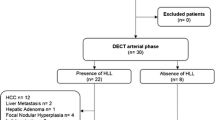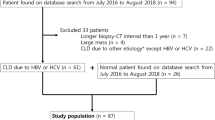Abstract
Purpose
To study the impact of keV levels of virtual monoenergetic images generated from rapid kVp-switching dual-energy CT (rsDECT) on CT texture analysis (CTTA).
Methods
This study included 30 consecutive patients (59.3 ± 12 years; range 34–77 years; 17M:13F) who underwent portal venous phase abdominal CT on a rsDECT scanner. Axial 5-mm monoenergetic images at 5 energy levels (40/50/60/70/80 keV) were created and CTTA of liver was performed. CTTA comprised a filtration-histogram technique with different spatial scale filter (SSF) values (0–6). CTTA quantification at each SSF value included histogram-based statistical parameters such as mean intensity, standard deviation (SD), entropy, mean of positive pixels (MPP), skewness, and kurtosis. The values were compared using repeated measures ANOVA.
Results
Among the different CTTA metrics, mean intensity (at SSF > 0), skewness, and kurtosis did not show variability whereas entropy, MPP, and SD varied with different keV levels. There was no change in skewness and kurtosis values for all 6 filters (p > 0.05). Mean intensity showed no change for filters 2–6 (p > 0.05). Mean intensity at SSF = 0 i.e., mean attenuations were 91.2 ± 2.9, 108.7 ± 3.6, 136.1 ± 4.7, 179.8 ± 6.9, and 250.5 ± 10.1 HU for 80, 70, 60, 50, and 40 keV images, respectively demonstrating significant variability (decrease) with increasing keV levels (p < 0.001). Entropy, MPP, and SD values showed a statistically significant decrease with increasing keV of monoenergetic images on all 6 filters (p < 0.001).
Conclusion
The energy levels of monoenergetic images have variable impact on the different CTTA parameters, with no significant change in skewness, kurtosis, and filtered mean intensity whereas significant decrease in mean attenuation, entropy, MPP, and SD values with increasing energy levels.


Similar content being viewed by others
References
Gerlinger M, Rowan AJ, Horswell S, et al. (2012) Intratumor heterogeneity and branched evolution revealed by multiregion sequencing. N Engl J Med 366(10):883
Davnall F, Yip CSP, Ljungqvist G, et al. (2012) Assessment of tumor heterogeneity: an emerging imaging tool for clinical practice? Insights Imaging. 3(6):573–589
Ganeshan B, Miles KA (2013) Quantifying tumour heterogeneity with CT. Cancer Imaging Off Publ Int Cancer Imaging Soc. 26(13):140–149
Armato SG, Li F, Giger ML, et al. (2002) Lung cancer: performance of automated lung nodule detection applied to cancers missed in a CT screening program. Radiology. 225(3):685–692
Armato SG, Giger ML, MacMahon H (2001) Automated detection of lung nodules in CT scans: preliminary results. Med Phys. 28(8):1552–1561
Giger ML, Bae KT, MacMahon H (1994) Computerized detection of pulmonary nodules in computed tomography images. Invest Radiol. 29(4):459–465
Halligan S, Mallett S, Altman DG, et al. (2011) Incremental benefit of computer-aided detection when used as a second and concurrent reader of CT colonographic data: multiobserver study. Radiology. 258(2):469–476
Lawrence EM, Pickhardt PJ, Kim DH, Robbins JB (2010) Colorectal polyps: stand-alone performance of computer-aided detection in a large asymptomatic screening population. Radiology. 256(3):791–798
Li J, Van Uitert R, Yao J, et al. (2008) Wavelet method for CT colonography computer-aided polyp detection. Med Phys. 35(8):3527–3538
Gletsos M, Mougiakakou SG, Matsopoulos GK, et al. (2003) A computer-aided diagnostic system to characterize CT focal liver lesions: design and optimization of a neural network classifier. IEEE Trans Inf Technol Biomed Publ IEEE Eng Med Biol Soc. 7(3):153–162
Huang Y-L, Chen J-H, Shen W-C (2006) Diagnosis of hepatic tumors with texture analysis in nonenhanced computed tomography images. Acad Radiol. 13(6):713–720
Kido S, Kuriyama K, Higashiyama M, Kasugai T, Kuroda C (2002) Fractal analysis of small peripheral pulmonary nodules in thin-section CT: evaluation of the lung-nodule interfaces. J Comput Assist Tomogr. 26(4):573–578
Klein HM, Klose KC, Eisele T, et al. (1993) The diagnosis of focal liver lesions by the texture analysis of dynamic computed tomograms. ROFO Fortschr Geb Rontgenstr Nuklearmed. 159(1):10–15
Way TW, Sahiner B, Chan H-P, et al. (2009) Computer-aided diagnosis of pulmonary nodules on CT scans: improvement of classification performance with nodule surface features. Med Phys. 36(7):3086–3098
Ganeshan B, Skogen K, Pressney I, Coutroubis D, Miles K (2012) Tumour heterogeneity in oesophageal cancer assessed by CT texture analysis: preliminary evidence of an association with tumour metabolism, stage, and survival. Clin Radiol. 67(2):157–164
Ganeshan B, Abaleke S, Young RCD, Chatwin CR, Miles KA (2010) Texture analysis of non-small cell lung cancer on unenhanced computed tomography: initial evidence for a relationship with tumour glucose metabolism and stage. Cancer Imaging Off Publ Int Cancer Imaging Soc. 6(10):137–143
Ganeshan B, Panayiotou E, Burnand K, Dizdarevic S, Miles K (2012) Tumour heterogeneity in non-small cell lung carcinoma assessed by CT texture analysis: a potential marker of survival. Eur Radiol. 22(4):796–802
Haider MA, Vosough A, Khalvati F, et al. (2017) CT texture analysis: a potential tool for prediction of survival in patients with metastatic clear cell carcinoma treated with sunitinib. Cancer Imaging. 17:4
Ng F, Ganeshan B, Kozarski R, Miles KA, Goh V (2013) Assessment of primary colorectal cancer heterogeneity by using whole-tumor texture analysis: contrast-enhanced CT texture as a biomarker of 5-year survival. Radiology. 266(1):177–184
Ozkan E, West A, Dedelow JA, et al. (2015) CT gray-level texture analysis as a quantitative imaging biomarker of epidermal growth factor receptor mutation status in adenocarcinoma of the lung. Am J Roentgenol. 205(5):1016–1025
Shac Y, Liu L, Wang F, et al. (2008) Quantitative evaluation of CT-MRI images of various tumors with expansive or infiltrative growth pattern. Zhonghua Yi Xue Za Zhi. 88(21):1503–1506
Win T, Miles KA, Janes SM, et al. (2013) Tumor heterogeneity and permeability as measured on the CT component of PET/CT predict survival in patients with non-small cell lung cancer. Clin Cancer Res Off J Am Assoc Cancer Res. 19(13):3591–3599
Hayano K, Tian F, Kambadakone AR, et al. (2015) Texture analysis of non-contrast enhanced CT for assessing angiogenesis and survival of soft tissue sarcoma. J Comput Assist Tomogr. 39(4):607–612
Goh V, Ganeshan B, Nathan P, et al. (2011) Assessment of response to tyrosine kinase inhibitors in metastatic renal cell cancer: CT texture as a predictive biomarker. Radiology. 261(1):165–171
Ahn SJ, Kim JH, Park SJ, Han JK (2016) Prediction of the therapeutic response after FOLFOX and FOLFIRI treatment for patients with liver metastasis from colorectal cancer using computerized CT texture analysis. Eur J Radiol. 85(10):1867–1874
De Cecco CN, Ganeshan B, Ciolina M, et al. (2015) Texture analysis as imaging biomarker of tumoral response to neoadjuvant chemoradiotherapy in rectal cancer patients studied with 3-T magnetic resonance. Invest Radiol. 50(4):239–245
Rao S-X, Lambregts DM, Schnerr RS, et al. (2016) CT texture analysis in colorectal liver metastases: A better way than size and volume measurements to assess response to chemotherapy? United Eur Gastroenterol J. 4(2):257–263
Ravanelli M, Farina D, Morassi M, et al. (2013) Texture analysis of advanced non-small cell lung cancer (NSCLC) on contrast-enhanced computed tomography: prediction of the response to the first-line chemotherapy. Eur Radiol. 23(12):3450–3455
Yip SSF, Coroller TP, Sanford NN, et al. (2016) Use of registration-based contour propagation in texture analysis for esophageal cancer pathologic response prediction. Phys Med Biol. 61(2):906–922
Tian F, Hayano K, Kambadakone AR, Sahani DV (2015) Response assessment to neoadjuvant therapy in soft tissue sarcomas: using CT texture analysis in comparison to tumor size, density, and perfusion. Abdom Imaging. 40(6):1705–1712
Wu J, Gong G, Cui Y, Li R (2016) Intratumor partitioning and texture analysis of dynamic contrast-enhanced (DCE)-MRI identifies relevant tumor subregions to predict pathological response of breast cancer to neoadjuvant chemotherapy. J Magn Reson Imaging JMRI. 44(5):1107–1115
Teruel JR, Heldahl MG, Goa PE, et al. (2014) Dynamic contrast-enhanced MRI texture analysis for pretreatment prediction of clinical and pathological response to neoadjuvant chemotherapy in patients with locally advanced breast cancer. NMR Biomed. 27(8):887–896
Michoux N, Van den Broeck S, Lacoste L, et al. (2015) Texture analysis on MR images helps predicting non-response to NAC in breast cancer. BMC Cancer. 5(15):574
Ahmed A, Gibbs P, Pickles M, Turnbull L (2013) Texture analysis in assessment and prediction of chemotherapy response in breast cancer. J Magn Reson Imaging JMRI. 38(1):89–101
Parakh A, Baliyan V, Sahani DV (2017) Dual-energy CT in focal and diffuse liver disease. Curr Radiol Rep. 5(8):35
Parakh A, Patino M, Sahani DV. Spectral CT/dual-energy CT. In Springer Berlin Heidelberg; 2017 [cited 2017 Apr 3]. p. 1–21. (Medical Radiology). http://link.springer.com.ezp-prod1.hul.harvard.edu/chapter/10.1007/174_2017_28
Patel BN, Alexander L, Allen B, et al. (2017) Dual-energy CT workflow: multi-institutional consensus on standardization of abdominopelvic MDCT protocols. Abdom Radiol. 42(3):676–687
Mileto A, Barina A, Marin D, et al. (2015) Virtual monochromatic images from dual-energy multidetector CT: variance in CT numbers from the same lesion between single-source projection-based and dual-source image-based implementations. Radiology. 279(1):269–277
Ganeshan B, Goh V, Mandeville HC, et al. (2013) Non-small cell lung cancer: histopathologic correlates for texture parameters at CT. Radiology. 266(1):326–336
Miles KA, Ganeshan B, Hayball MP (2013) CT texture analysis using the filtration-histogram method: what do the measurements mean? Cancer Imaging Off Publ Int Cancer Imaging Soc. 13(3):400–406
Hsu CC-T, Kwan GNC, Singh D, Pratap J, Watkins TW. Principles and clinical application of dual-energy computed tomography in the evaluation of cerebrovascular disease. J Clin Imaging Sci [Internet]. 2016 Jun 29 [cited 2017 Jun 14];6. : http://www.ncbi.nlm.nih.gov/pmc/articles/PMC4964665/
Kaza RK, Ananthakrishnan L, Kambadakone A, Platt JF (2017) Update of dual-energy CT applications in the genitourinary tract. Am J Roentgenol. 208(6):1185–1192
Roele ED, Timmer VCML, Vaassen LAA, van Kroonenburgh AMJL, Postma AA. Dual-energy CT in head and neck imaging. Curr Radiol Rep [Internet]. 2017 [cited 2017 Jun 14];5(5). http://www.ncbi.nlm.nih.gov/pmc/articles/PMC5371622/
Liguori C, Frauenfelder G, Massaroni C, et al. (2015) Emerging clinical applications of computed tomography. Med Devices Auckl NZ. 5(8):265–278
De Cecco CN, Boll DT, Bolus DN, et al. (2017) White paper of the society of computed body tomography and magnetic resonance on dual-energy CT, part 4: abdominal and pelvic applications. J Comput Assist Tomogr. 41(1):8–14
Ganeshan B, Miles KA, Young RCD, Chatwin CR (2007) In search of biologic correlates for liver texture on portal-phase CT. Acad Radiol. 14(9):1058–1068
Ganeshan B, Miles KA, Young RCD, Chatwin CR (2009) Texture analysis in non-contrast enhanced CT: impact of malignancy on texture in apparently disease-free areas of the liver. Eur J Radiol. 70(1):101–110
Miles KA, Ganeshan B, Griffiths MR, Young RCD, Chatwin CR (2009) Colorectal cancer: texture analysis of portal phase hepatic CT images as a potential marker of survival. Radiology. 250(2):444–452
Agrawal MD, Pinho DF, Kulkarni NM, et al. (2014) Oncologic applications of dual-energy CT in the abdomen. RadioGraphics. 34(3):589–612
Yu L, Leng S, McCollough CH (2012) Dual-energy CT-based monochromatic imaging. AJR Am J Roentgenol. 199(5 Suppl):S9–S15
Author information
Authors and Affiliations
Corresponding author
Ethics declarations
Disclosure
Balaji Ganeshan: director, part-time employee, and shareholder of Feedback Plc (Cambridge, England, UK), company that develops and markets the TexRAD texture analysis algorithm described in this manuscript. Dushyant Sahani: GE healthcare research grant, royalties from Elsevier.
Funding
This study was not funded.
Ethical approval
This article does not contain any studies with human participants performed by any of the authors.
Conflict of Interest
Balaji Ganeshan is director, part-time employee, and shareholder of Feedback Plc (Cambridge, England, UK), company that develops and markets the TexRAD texture analysis algorithm described in this manuscript. Dushyant Sahani has GE healthcare research grant, royalties from Elsevier, other authors declare that they have no conflict of interest.
Rights and permissions
About this article
Cite this article
Baliyan, V., Kordbacheh, H., Parameswaran, B. et al. Virtual monoenergetic imaging in rapid kVp-switching dual-energy CT (DECT) of the abdomen: impact on CT texture analysis. Abdom Radiol 43, 2693–2701 (2018). https://doi.org/10.1007/s00261-018-1527-y
Published:
Issue Date:
DOI: https://doi.org/10.1007/s00261-018-1527-y




